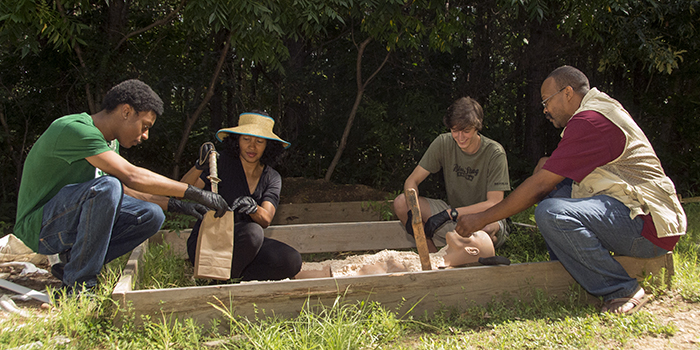
Professor Robert Belcher, right, instructs students, from left, Lamond Brown, Nicole Gordon Brown and Mac Brooks at forensic dig site. (photo by Bill Roa)
Students dig campus archeological sites
Some Georgia Perimeter College students are getting their hands dirty for the sake of learning.
GPC now is home to two archeological dig sites, resulting from the vision and muscle of professors Robert Belcher and Megan Parker who turned soil and planted artifacts to establish beds on the Dunwoody and Alpharetta campuses.
“There’s only so much you can get out of a book,” says Dr. John Redmond, anthropology professor and Cultural and Behavioral Science department chair.
Each boxed bed is about 1 1/2 to 2 feet deep and 8 feet on each side. They’ve been stocked with varied artifacts including glassware, pottery shards and fake bones.
Parker, an anthropology instructor, says the beds were created to reflect varying historical time periods which are denoted by the use of soil dyed different colors.
“It was a break from the classroom,” she says of the times her students visited the Dunwoody dig site. “It solidifies the lesson in a different context.”
Belcher, who has experience conducting archaeological field research at Thomas Jefferson’s Monticello plantation, explains to his students that excavation is similar to reading a book. “But as you dig, you destroy your data, so you have to be a keen observer of the signs and symbols of what humans have done.”
For this reason, Belcher requires his students to capture notes from their dig and be responsible with the artifacts—even though they’re staged. Most of what the students excavate is returned to the soil and that which is inspected is done with respect to harming the artifact as little as possible.
“When you excavate some things, they are so delicate that we use eyeliner brushes to dust them off,” says Belcher.
Kekuta Jatta was one of Belcher’s students. “I think it’s a good experience,” Jatta says of digging around in the archeological pit at Dunwoody. “I learned a lot from his class.”
The archeology beds also have led to cross-curriculum teaching, with criminal justice students studying forensics and anthropology students working on some group projects. Redmond says anthropology instructors also are looking for ways to co-teach with geology professors to infuse global positioning systems (GPS) concepts into the archeological digs.
“We’re getting students engaged and getting them out the classroom with applied techniques,” Redmond says.
